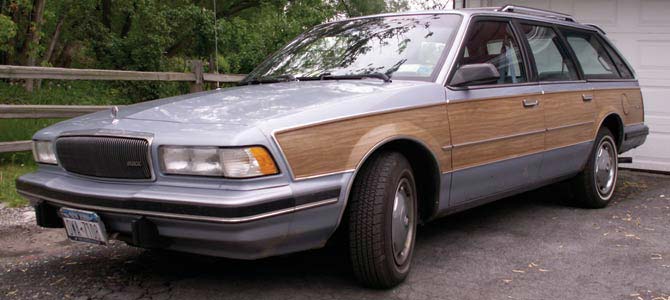Cash for Clunkers: Ugh!
by Jim Corbran

That’s about all I can say. Ugh.
While the know-it-alls in Washington try to satisfy the taxpayers by giving them back some of their hard-earned cash, they didn’t really think this whole thing through very well. And if they think throwing a few thousand dollars at some of us will make up for the billions (wait, is it trillions yet?) they handed over to their buddies in the financial world…ugh.
Here’s a prime example of what’s wrong with the program. I drive a wood-grained 1995 Buick Century station wagon. Very reliable. Ugly as hell. It’s EPA-rated at 17 miles per gallon in the city and 26 miles per gallon on the open road. And believe it or not, with almost 136,000 on the odometer, I’m still averaging around 21 miles per gallon on my daily drive, which is about 80 percent highway and 20 percent city driving. Not bad for a 15-year-old clunker.
But wait a minute—according to the federal government, my beloved woodie is not a clunker. I checked it out on the government’s official program website: cars.gov. Because my car gets a combined EPA miles per gallon of 20, it doesn’t qualify for a rebate, as the cutoff number is 18 miles per gallon. Not even if I were trading it in on a 2010 Volkswagen Jetta Sportwagen with the TDI diesel engine, which gets 30 city/42 highway. I’d be almost doubling my gas mileage, but the government doesn’t care.
But let’s say I was trading a 2004 Ford Escape (with a Kelley Blue Book value 0f $3,900) for a 2010 Ford Escape. The 2004 has a combined EPA rating of 18, which means it just qualifies, and the new Escape has a rating of 24. No problem; here’s the $4,500 rebate, sir, and thanks for your business!
What’s wrong with this picture? Under the program, the 2004 Edge will have to be destroyed. A six-year-old car with maybe 80,000 miles on the odometer, which still gets better gas mileage than a lot of stuff still on the road. No, the program is meant more for people like me with older cars who up to this point have been reluctant (or too cheap) to trade them in. My Century has a Kelly Blue Book trade-in value of around $600. Not too bad considering I paid $750 for it two-and-a-half years ago. And from what I’ve been reading, it’s people like me with cars somewhat like mine—third vehicles which they had no intention of getting rid of until someone offered crazy money for them—who are taking advantage of the government cash rebates. In this sense it’s not about saving gas, it’s about selling cars to them and to people who were probably buying soon anyway. It will be interesting to see what this spike in new car sales does to sales later this year, when the cash-for-clunkers money dries up.
Other problems? There’s nothing to stop anyone from trading their 1991 Porsche 928 (15 miles per gallon), which probably sits in the garage most of the year anyway, on a new 2010 Saab 9-3 turbocharged convertible. That transaction would earn you a $3,500 rebate. I doubt that’s the kind of deal our elected officials had in mind when they rammed this program through. They were looking for guys like me. Or they thought they were.
Although it’s probably too late now, with Washington having been deserted until September, Congress really should look into changing the rules of this game if they ever play it again. It wouldn’t make a difference to me, as I’m not buying right now no matter what. But people in situations like me and my woodie should be able to cash in, too. Why not make the rule you must increase your new miles per gallon by either a certain percentage or a certain number? Who decided 18 was okay but 20 wasn’t? If I were to trade today the car I’d buy would probably come close to doubling the Buick’s miles per gallon, so…why not?
Sometimes all one can say is “ugh.”
Read more of Jim Corbran's You Auto Know on Artvoice Daily.
blog comments powered by Disqus|
Issue Navigation> Issue Index > v8n33 (week of Thursday, August 12, 2009) > Cash for Clunkers: Ugh! This Week's Issue • Artvoice Daily • Artvoice TV • Events Calendar • Classifieds |









 Current Issue
Current Issue